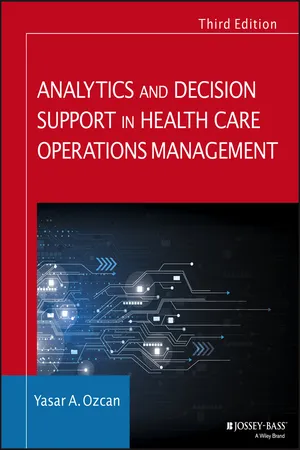
- English
- ePUB (mobile friendly)
- Available on iOS & Android
Analytics and Decision Support in Health Care Operations Management
About this book
Analytics and Decision Support in Health Care Operations is a comprehensive introductory guide to quantitative techniques, with practical Excel-based solutions for strategic health care management. This new third edition has been extensively updated to reflect the continuously evolving field, with new coverage of predictive analytics, geographical information systems, flow process improvement, lean management, six sigma, health provider productivity and benchmarking, project management, simulation, and more. Each chapter includes additional new exercises to illustrate everyday applications, and provides clear direction on data acquisition under a variety of hospital information systems. Instructor support includes updated Excel templates, PowerPoint slides, web based chapter end supplements, and data banks to facilitate classroom instruction, and working administrators will appreciate the depth and breadth of information with clear applicability to everyday situations.
The ability to use analytics effectively is a critical skill for anyone involved in the study or practice of health services administration. This book provides a comprehensive set of methods spanning tactical, operational, and strategic decision making and analysis for both current and future health care administrators.
- Learn critical analytics and decision support techniques specific to health care administration
- Increase efficiency and effectiveness in problem-solving and decision support
- Locate appropriate data in different commonly-used hospital information systems
- Conduct analyses, simulations, productivity measurements, scheduling, and more
From statistical techniques like multiple regression, decision-tree analysis, queuing and simulation, to field-specific applications including surgical suite scheduling, roster management, quality monitoring, and more, analytics play a central role in health care administration. Analytics and Decision Support in Health Care Operations provides essential guidance on these critical skills that every professional needs.
Frequently asked questions
- Essential is ideal for learners and professionals who enjoy exploring a wide range of subjects. Access the Essential Library with 800,000+ trusted titles and best-sellers across business, personal growth, and the humanities. Includes unlimited reading time and Standard Read Aloud voice.
- Complete: Perfect for advanced learners and researchers needing full, unrestricted access. Unlock 1.4M+ books across hundreds of subjects, including academic and specialized titles. The Complete Plan also includes advanced features like Premium Read Aloud and Research Assistant.
Please note we cannot support devices running on iOS 13 and Android 7 or earlier. Learn more about using the app.
Information
Chapter 1
Introduction to Analytics and Decision Support in Health Care Operations Management
Learning Objectives
- Recognize the analytical techniques for decisions about delivering health care of high quality.
- Describe the historical background and the development of decision techniques.
- Describe the health care manager's role and responsibilities in decision making.
- Review the scope of health services and follow recent trends in health care.
- Describe health services management and distinct characteristics of health services.
- Describe the data flow in health care organizations and how to organize data for analytics.
Historical Background and the Development of Decision Techniques
Table of contents
- Cover
- Title Page
- Copyright
- Dedication
- Tables & Figures
- Acknowledgments
- The Author
- Introduction
- Chapter-by-Chapter Revisions for the Third Edition
- Chapter 1: Introduction to Analytics and Decision Support in Health Care Operations Management
- Chapter 2: Predictive Analytics
- Chapter 3: Decision Making in Health Care
- Chapter 4: Facility Location
- Chapter 5: Facility Layout
- Chapter 6: Flow Processes Improvement: Reengineering and Lean Management
- Chapter 7: Staffing
- Chapter 8: Scheduling
- Chapter 9: Productivity and Performance Benchmarking
- Chapter 10: Resource Allocation
- Chapter 11: Supply Chain and Inventory Management
- Chapter 12: Quality Control and Improvement
- Chapter 13: Project Management
- Chapter 14: Queuing Models and Capacity Planning
- Chapter 15: Simulation
- Appendixes
- References
- Index
- End User License Agreement